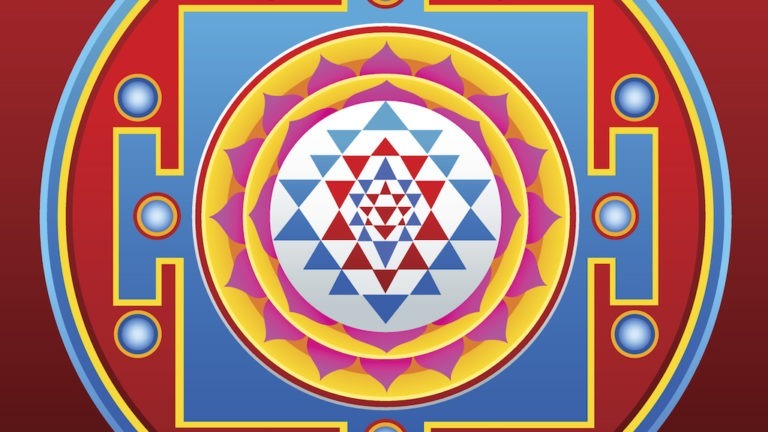Unraveling Sri Yantra’s Meaning & Ancient Symbols

It’s everywhere in the West—on t-shirts, jewelry, coffee cups, and wall decals. The ancient Sri Yantra, also known as Shri Yantra, Shree Yantra, or Sri Chakra, has become a trendy design. However, most don’t realize the complexity, meaning, and symbology of the nine interlocking triangles and double rings of lotus petals. It has been used in India for centuries and is considered a powerful Hindu symbol—so much so that Russian scientists used EEG technology to prove that the Sri Yantra geometry quickly brought viewers to a meditative state in 1987.
What is Sri Yantra?
The Sri Yantra is a sacred and complex geometric pattern or mystical diagram that has deep spiritual significance in Hinduism and other Indian spiritual traditions, including Buddhism, particularly within Tantric traditions. It consists of nine interlocking triangles that radiate out from a central point, surrounded by two concentric circles of lotus petals. The Sri Yantra represents the unity of the divine masculine and feminine energies, as well as the structure of the entire cosmos. It is used for meditation and is believed to bring about spiritual, mental, and physical well-being when properly understood and revered.
In Sanskrit, “Sri” (also spelled as “Shri” or “श्री” in Devanagari script) is a term often used as a respectful prefix before the names of deities, individuals, and even in the context of various sacred or auspicious objects. It is a symbol of reverence, prosperity, and grace, and it’s commonly used to show respect or invoke blessings. In a broader sense, “Sri” can be associated with qualities such as beauty, wealth, radiance, and divine grace.
In Sanskrit, the word “yantra” comes from the root word “yam,” which means “instrument” or “support,” and “tra,” derived from “trana,” meaning “release from bondage.” A yantra is an instrument or tool for meditation and contemplation and supports spiritual liberation. There are hundreds of yantra designs related to deities, principles, and planets. Used in ceremonies and rituals, yantra designs can be found on paper or bark or created from flower petals, ash, and rice.
For meditation practices, or “Vastu,” the Vedic version of Feng shui, a yantra is embossed on a square copper plate electroplated with gold. The plates are then ritually “charged” by priests—meaning that the physical object is “tuned” to a specific vibration or energy. Once charged, the yantra is viewed as a sacred object.
Sri Vidya
Sri Vidya is a profound spiritual tradition that centers on the worship of the Divine Mother, particularly in the form of the goddess Tripura Sundari. As mentioned, the term “Sri” signifies prosperity and auspiciousness, but “vidya” translates to knowledge or wisdom in Sanskrit. This tradition emphasizes the importance of understanding the feminine divine and the principles of creation. The Sri Yantra is not just a geometric symbol; it serves as the primary object of devotion in Sri Vidya, embodying the essence of this specific energy or life force.
The Queen of Yantras: The Shri Yantra
The Sri Yantra, called the “queen of yantras” (rajayantra), is a mandala and the symbol of the great Divine Mother principle, the source of all energy, power, and creativity. Vedic traditions, specifically the Sri Vidya school of tantra, regard the design as the representation of the universe as well as the body of the goddess related to the feminine principle of shakti, or energy. Every line, triangle, and lotus petal symbolizes a specific type of shakti.

Outer Square
The outer square represents the earth element. In Vedic sacred geometry, the square corresponds to the earth. The outside square represents mundane emotions, such as anger, fear, and worldly desires. The yogi meditates on the outer square to defeat these disturbing energies. The T-shape structures in the square are considered the gates of the four directions and the entry points of the yantra.
Outer Circle of 16 Lotus Petals
Next are three circles representing the past, present, and future. Within is the first ring of sixteen lotus petals that represents the complete fulfillment of all hopes and desires. Specifically, the petals represent the ten organs of perception and action (tongue, nose, mouth, skin, eyes, ears, feet, hands, arms, and reproductive organs) and the five elements: earth, water, fire, air, and space. The sixteenth petal represents the mind, which gathers and interprets information from the perceptions of the interactivity of the elements.
Inner Circle of 8 Lotus Petals
Next is an eight-petal lotus. Each petal governs a specific activity: speech, grasping, motion, excretion, enjoyment, revulsion, attraction, and equanimity. Within the inner lotus is the first set of interlocked triangles. The upward triangles represent the masculine (Shiva), and the downward-pointing triangles represent the feminine (Shakti) energies.
Starting at the lowermost outer triangle and moving in a counterclockwise circle, they are agitation, pursuit, attraction, delight, delusion, immobility, release, control, pleasure, intoxication, an accomplishment of desire, luxury, mantra, and the destruction of duality.
Inner Sequences of Triangles
The next circle has the same sequence and direction, starting from the lowest triangle and moving counterclockwise. The first triangle is the giver of all accomplishments. Next is the giver of wealth. The third is the energy of activities that please all. Fourth is the bringer of all blessings. The fifth is the granter of all desires. Next is the remover of all suffering. The seventh is considered the appeaser of death. Eighth is the overcomer of all obstacles. Ninth is the bringer of beauty, and the tenth is the giver of all good fortune.
The ten smaller triangles in the third circle, beginning at the same lowermost triangle and moving counterclockwise2, represent omniscience, omnipotence, sovereignty, knowledge, destruction of all disease, unconditional support, vanquishment of all evils, protection, and the attainment of all desires. The fourth circle of triangles, again starting at the same point and moving counterclockwise, represents sustaining, creating, dissolution, pleasure, pain, cold, heat, and the ability to choose action.
Inner Space
In the final inner space, the yogi or yogini visualizes five arrows representing the world of the senses, a bow representing the mind, a noose representing attachment, and a stick representing aversion. The central triangle is the giver of all perfection. In the middle of the central triangle is a Bindu, representing pure consciousness and the original state of being.
How to Use a Sri Yantra
You can use a Sri Yantra made of various materials, such as metal, crystal, wood, or a paper illustration. Just make sure it is authentic and accurately designed.
Made of Metal
If you are using a Sri Yantra in a home or office, the Vedics recommend that it face East. They also suggest occasionally bathing the yantra, if it is a copper and gold plate, in milk or rose water. If you want to go all out, place dots of sandalwood paste on the four corners of the yantra. Keep your yantra from accumulating dust or dirt. If the metal changes color from the milk/rosewater bath, it’s okay because the yantra is fine.
Drawn or Printed
Sri Yantra geometry is trickier than it looks—for centuries, mathematicians were required to create accurate Sri Yantras, free of mistakes. It was assumed that no matter how carefully it was created, there would be tiny inaccuracies that could not be seen with the naked eye. Bear in mind—the thicker the lines and the cruder the rendering of a Sri Yantra, the higher the odds that it is an inaccurate depiction. The Sri Yantra Research offers drawing instructions and software that renders mathematically accurate yantras.
Meditation Practice
Gazing meditation is a straightforward way to connect with Sri Yantra’s geometry. This technique, commonly used with sacred symbols, allows you to bring its powerful imagery into your consciousness.
What You’ll Need:
- A blank, white wall, board, or piece of paper
- An accurate Sri Yantra image (preferably a simple black-and-white version)
- Ensure all three points of the largest triangles touch the outer circle.
- The uppermost point of each triangle should touch the horizontal baseline of the next or lower triangle.
- A timer
Steps to Practice:
- Prepare Your Space: Find a comfortable sitting position that keeps you alert. Have your Sri Yantra image and your blank white surface ready. If you’re using a wall, ensure you have a clear view.
- Set Your Timer: Adjust the timer for five minutes.
- Begin Gazing: Start by gazing softly at the Sri Yantra image. Let your eyes relax and allow the image to gently enter your visual awareness.
- Maintain Focus: Stay present with the image. If your mind begins to wander, gently guide your focus back without any judgment or frustration.
- Transition to the Afterimage: When the timer goes off, shift your gaze to the blank white surface. Allow the afterimage to form, noticing how colors reverse (for instance, black turns to white). Continue gazing at the afterimage for as long as you can see it.
- Close Your Eyes: Once the afterimage fades, close your eyes and let any remaining afterimage emerge. Focus on it until it completely disappears.
Feel free to repeat this meditation as often as you like. For a deeper experience, try doing the practice for 30 days!
Remember that the Sri Yantra is a powerful and sacred symbol, and using it in your spiritual practice should be done with sincerity, reverence, and a deep understanding of its significance. It can be a tool for meditation, spiritual growth, and manifesting positive energies.
Want to learn how to bring Sri Yantra further into your spiritual journey? Start with this sound healing meditation that incorporates the Sri Yantra visual. We also recommend exploring other resources on sacred geometry.
10 Fun Facts About Breathing & the Respiratory System

Our ability to breathe is fascinating, as it’s one of the only systems in our body that can be controlled both voluntarily, through the central nervous system, and more often involuntarily, through the autonomic nervous system. This overlap between the two systems is the reason why focused, intentional breathing methods through yoga and meditation are able to affect other involuntary muscles like the heart.
Our breath is what gives us life and without it, the human body cannot exist. But is it possible to better your life by paying more attention to how you breathe?
While breathing is so commonplace to our existence, proper breathing techniques and awareness of breath can have dramatic implications on our health. Having knowledge of specific breathing techniques can lower stress, help you sleep, help your mind function more acutely, and even curb food cravings.
When we breathe, the average adult draws in about 13 pints of air into the lungs every minute. From the lungs, that oxygen is then transferred from the air sacs in our lungs throughout the body via red blood cells to the blood vessels that distribute it to nearly every system. Meanwhile, waste gases, like CO2, are exchanged and filtered out.
For the average person with good lung health, the amount of oxygen in the blood, or the arterial blood gas (ABG) oxygen level, should be somewhere between 95-100 percent oxygen.






